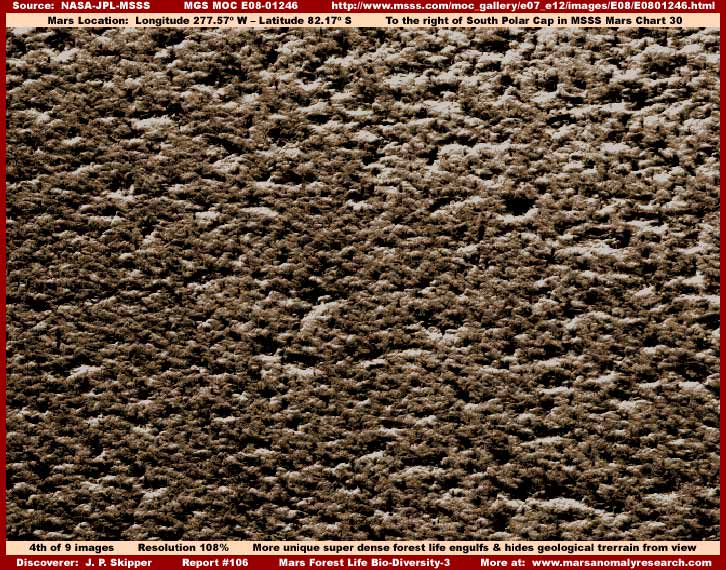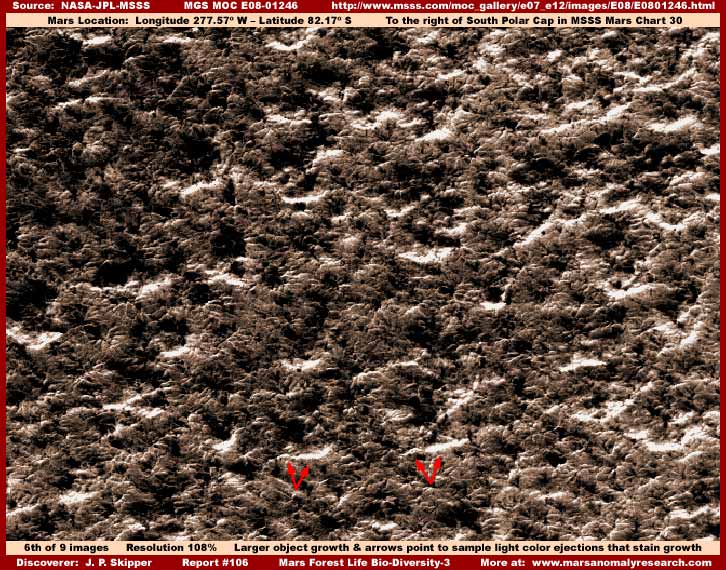
MARS FOREST LIFE BIO-
DIVERSITY-3b
Report #106
August 21, 2006
Back to Part 3a .......... Forward to Part-3c

The above fourth image here in Part-2 of this Report #106 is from the upper part of E08-01246 science data strip. It demonstrates a lower tending to be relatively level growing type of super dense Mars forest evidence. It is similar to the lumpy looking evidence in Part-1 but here it develops a small fringed top that tends to obscure the underlying lumpy appearance parts of which can be seen as light reflective surfaces. No terrain geology is visible in this strip as this growth engulfs and covers over everything else from one side edge to the other and from the bottom to top hiding it from view.
As you can see, while the scene is certainly too busy, a bit confusing, and overwhelming because of the sheer mass of detail so typical of this type of Mars massed forest evidence, the resolution is better in this strip than the strip in Part-1. What we are looking at may very well be a younger lower growing area of this forest temporarily in bloom with the fringed blooms catching more light and creating more shadow than the underlying smoother light reflective surfaces.
Even though it may look that way, I do not think that the many light color spots are light reflective terrain. Rather I suspect that this is the same lumpy type evidence as in Part-1 but here that aspect is mostly covered over and hidden by the development of clusters of branching tendril members on top. I base that conclusion not just on the above image visuals but also on how this spot relates to other areas in the rest of the strip which is filled with this evidence continuously from strip edge to edge.
Whether true or not there is one thing I am certain of, we are not viewing any kind of Mars rock and soil geology here, only dense carpeting and flourishing life. The visible patterns are just too consistently uniform typical of single species plant growth even though this may very well not be exactly vegetation in the strictest sense of the term that we are familiar with.

The above fifth image is a location further down in the strip below the above fourth image. I suspect that this is basically the same evidence as in the fourth image but here the growth may be a little older and more mature with the underlying lumpy knobby harder surface true forest evidence erupting in larger folds and lumps more to the surface. Look very close and you will see branching members and bunches of same are still on top of it in various spots.
One way or the other, we're most definitely looking at life here, not inanimate geological rocks and soil. Toss a nickel down there and I suspect it would bounce and not be able to penetrate below the top level of this super dense life competing for space. Lets face it, when one contemplates about the presence of biological forest life on Mars, one is at times going to have to start thinking out the box and move away from what is familiar looking to the Earth human eye, that is if accuracy is the desired goal.

The above sixth image taken from an area near the bottom of the same strip and it demonstrates what I suspect is a more mature and a bit larger form of this same biological life evidence. Even though the evidence is even better seen here, these strips typically all suffer from various forms of poor resolution. In this strip's case, it cannot be zoomed in on to any significant degree before pixelation becomes a problem compromising the image quality. Even so, I think that we can all still tell that we are clearly looking at some form of Mars ground life here and not inanimate geology.
I'm sorry for not supplying a zoomed in version of this stronger evidence image. Unfortunately, despite its clear look at the relatively tiny 108% zoom factor I do have on it, the official resolution in the image has been degraded and any more zoom will very quickly encounter too many visual problems like blur and pixelation. This is typical of most images of this type of forest life evidence. I can only assume they thought that we wouldn't be able to recognize much of anything at this resolution. If so, they were mistaken.
There is one additional element to consider though. Note the red arrows in the above sixth image. They point out was appears to be light color plumes of material ejected into the air down wind over the forest. I suspect that some or all of the other light color patches on and over this forest are either such plumes or plume residue coating the top of the evidence. If so, this and the physical appearance of the evidence reminds that we may very well be looking at colony life forms here as opposed to true vegetation, at least in the forms we are familiar with.
You should also be aware that the files sizes of these three images here in Part-2 are very high as compared to regular Mars terrain geology images in spite of being considerably .JPEG compressed. That tells me that these objects in this great multitude are not soft but relatively hard surfaced resulting in higher than normal graphics software counts. That to would be typical of some colony life forms we are more familiar with here on Earth that tend to build harder structures in their growth and spreading processes.
Finally, what does an image like this tell you in general? Does anything down there really look like just chaotic terrain geology to you? NASA, JPL, their associates, and the general science communities, all in agreement, would have you believe that Mars is a hard frozen, dry, dead world with a primarily CO2 atmosphere deadly by several times over to life as we know it. Further, that mainstream concept is backed up by the current rover imaging demonstrating barren landscapes and a lot of instrument derived test data. How does this evidence compare to that? What do you think? Do you think a rover would be able to roam around down there in this locale? How would it do?
Not sure but beginning to question? Okay now let's move on to Part-3 of this report at the link below and view some more similar looking evidence with more very big file sizes that may offer even more insight.
DOCUMENTATION
http://www.msss.com/moc_gallery/e07_e12/images/E08/E0801246.html: This link takes you to the official E08-01246 science data strip that my above fourth, fifth and sixth images were sourced from.
![]()